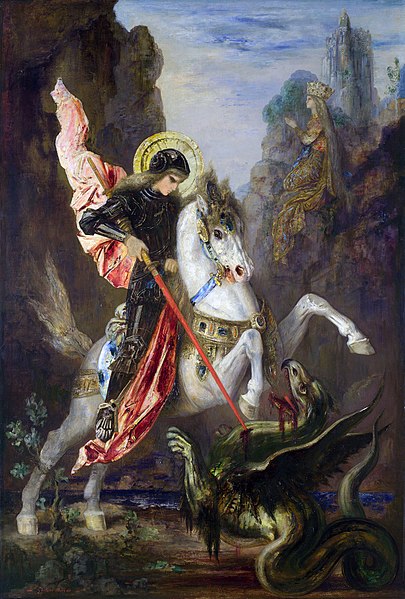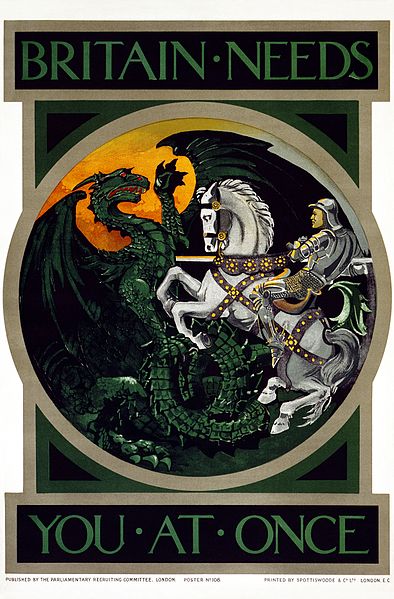 |
| St. George and the Dragon, 1899 oil by Gustave Moreau. |
St. George's Day
We might as well start out talking about St. George Day, or the Feast of St. George, since so many of today's observances are linked to him. It's celebrated by the Roman Catholic Church. It's celebrated by the various Orthodox Churches, although not necessarily on the same day. St. George is the patron saint of England, so of course it's observed in most of the British Commonwealth. He's also the patron saint of a whole bunch of towns and cities all over the world, so we get St. George's Day celebrations there as well.Who was St. George? It's believed that he lived during the late third and early fourth century AD, and belonged to a noble Christian family in the city of Lod. Lod is now located in Israel. At the time it was in the Roman province of Syria Palaestina. He became a soldier of the imperial guard for the Emperor Diocletian. When Diocletian ordered all of his Christian soldiers to convert to paganism or die, George refused.
George was tortured on the wheel of swords and resuscitated three times before being beheaded. So great was his faith that the Empress Alexandra and a pagan priest named Athanasius were moved to become Christians and died as well. Shortly after his death, George began being honored as a martyr. In 494 he was canonized by Pope Gelasius I.
 |
| George did a little recruiting during WWI. |
The first mention of St. George in England is in the writings of the Venerable Bede in the seventh century. The Feast Day of St. George was celebrated in England and eventually became a major holiday, on a par with Christmas. The flag of St. George, a red cross on a white background, became the emblem of England and later was incorporated as part of the Union Jack.
Birth of William Shakespeare, 1564
Death of William Shakespeare, 1616
It seems appropriate that the life of England's greatest writer is doubly associated with St. George's day. Of course, we're pretty much guessing at his date of birth, but he was baptized on April 26, so it seems a pretty reasonable guess. The date of his death is better documented, and he was buried two days later.
I'm not even going to try to summarize Shakespeare's life, his works, or his importance in this brief article. I would like to point out, however, that his character, Henry V, invoked St. George at the Battle of Agincourt: "Follow your spirit, and upon this charge cry, 'God for Harry, England, and St. George!'"
 |
| A procession of Shakepeare's characters by an unknown 19th century artist. |
 |
| Cervantes -- not a very good bookkeeper. |
Death of Cervantes, 1616
This is where things get interesting. Shakespeare died on April 23, 1616. Cervantes died on April 23, 1616. But Cervantes died ten days before Shakespeare.The answer to this paradox is that different calendars were then in effect in England and Spain. England was using the Julian, or old style, calendar. Spain had adopted the Gregorian, or new style, calendar.
To make it a little more complicated, we're not sure that Cervantes actually died on April 23. Some claim that the date cited is actually the date on his tombstone, which, according to local custom, would have been the date he was buried. In that case, it is most likely that he died on the 21st or 22nd.
And we can't verify the tombstone, either, because we don't know where he's buried. According to his will, he was to be buried at a nearby convent of Trinitarian nuns, where his daughter was a member. However, the nuns moved to another location a few years after his death and some of the dead went with them. We don't know whether or not Cervantes's body was one of them.
Cervantes was born Miguel de Cervantes in 1547. He wrote numerous novels, plays, and poems, but is best known for his great work, Don Quixote, considered by many to be the first modern novel. It is believed that he got the idea for his novel while he was imprisoned in La Mancha. He was a purchasing agent for the Spanish Armada and a tax collector, and his accounts suffered a few irregularities.
World Book and Copyright Day
April 23rd has been celebrated as World Book and Copyright Day by the United Nations since 1995. The date was chosen, in part, because of its connection to William Shakespeare and Miguel de Cervantes.Another connection between reading and April 23rd is in one of the annual traditions of Catalonia, Spain. Since medieval times, it has been customary for men to give their lovers roses on St. George's Day. The women, since the 1920's anyway, respond by giving their men a book. The custom has been promoted by the booksellers of the area, and accounts for about half of the yearly book sales.
Bermuda Peppercorn Ceremony
Back in 1816, the capitol of Bermuda was moved from St. George to Hamilton City. That left the question of what to do with the Old State House. The Freemasons were interested in it, so they rented it -- for the price of one peppercorn a year.The bargain still stands and every year the Freemasons faithfully pay their rent, on St. George's Day, of course. It's a grand pageant. The governor arrives in a horse-drawn carriage, and there are parades, military guards and bands, and a 17-gun salute. The Freemasons then present the governor with the peppercorn, resting on a velvet cushion on a silver platter.

No comments:
Post a Comment